Samsung Galaxy S 6 and S 6 Edge: Preview
by Joshua Ho on March 26, 2015 9:00 AM EST- Posted in
- Smartphones
- Samsung
- Mobile
- Galaxy S6
- Galaxy S6 Edge
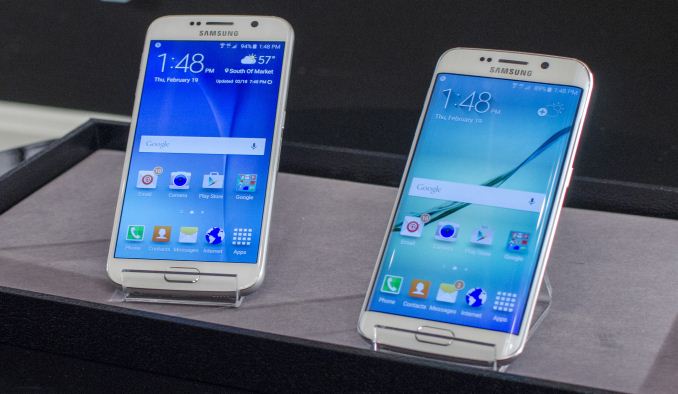
Yesterday we received our Galaxy S6 and S6 edge review units. We’re still working on the final review but I wanted to share some early results from both devices. For those that are unfamiliar with these two phones, the Galaxy S6 range represents the result of Samsung’s “Project Zero”. In fact, the phones seem to have the internal name of Zero, which can be seen in terminal, and the build properties of both devices. For Samsung, these phones represent their attempt at completely rethinking how Samsung makes phones. There is a strong emphasis on a new unibody design, which has no visible gaps or screws. Rather than the plastic that previous Samsung phones have been known for, the new design is composed of metal and glass. Samsung’s design team has been given unprecedented control throughout the process of making this phone and the result of this is a Galaxy phone that looks unlike anything else they’ve ever released.
Even if design is important, it isn’t enough to make the phone. Samsung has also outfitted the Galaxy S6 and S6 edge with their latest technologies, from a new AMOLED display to a new camera module. The specs for both phones can be seen below.
| Samsung Galaxy S5 | Samsung Galaxy S6 | Samsung Galaxy S6 Edge | |
| SoC | MSM8974ACv3 2.45 GHz Snapdragon 801 | Exynos 7420 2.1/1.5GHz A57/A53 | Exynos 7420 2.1/1.5GHz A57/A53 |
| RAM/NAND | 2GB LPDDR3 16/32GB NAND + microSD |
3GB LPDDR4-1552 32/64/128GB NAND |
3GB LPDDR4-1552 32/64/128GB NAND |
| Display | 5.1” 1080p SAMOLED HD |
5.1” 1440p SAMOLED |
5.1” 1440p SAMOLED, Dual Edge |
| Network | 2G / 3G / 4G LTE (Qualcomm MDM9x25 UE Category 4 LTE) | 2G / 3G / 4G LTE (Category 6 LTE) | 2G / 3G / 4G LTE (Category 6 LTE) |
| Dimensions | 142 x 72.5 x 8.1 mm, 145 grams | 143.4 x 70.5 x 6.8mm max, 138 grams | 142.1 x 70.1 x 7.0mm max, 132 grams |
| Camera | 16MP (5132 x 2988) Rear Facing with 1.12 µm pixels, 1/2.6" CMOS size, 31 mm (35mm effective), f/2.2 | 16MP (5132 x 2988) Rear Facing w/ OIS, f/1.9, object tracking AF | 16MP (5132 x 2988) Rear Facing w/ OIS, f/1.9, object tracking AF |
| 2MP Front Facing | 5MP Front Facing, f/1.9 | 5MP Front Facing, f/1.9 | |
| Battery | 2800 mAh (10.78 Whr) | 2550 mAh (9.81 Whr) | 2600 mAh (10.01 Whr) |
| OS | Android 4.4 w/TouchWiz |
Android 5 (64-bit) w/TouchWiz | Android 5 (64-bit) w/TouchWiz |
| Connectivity | 802.11a/b/g/n/ac 2x2 + BT 4.0 (BCM4354), USB3.0, GPS/GNSS, MHL, DLNA, NFC |
2x2 802.11a/b/g/n/ac + BT 4.1 (BCM4358), USB2.0, GPS/GNSS, NFC |
2x2 802.11a/b/g/n/ac + BT 4.1 (BCM4358), USB2.0, GPS/GNSS, NFC |
| Wireless Charging | N/A | WPC 1.1 (4.6W) & PMA 1.0 (4.2W) |
WPC 1.1 (4.6W) & PMA 1.0 (4.2W) |
| Fingerprint Sensor | Swipe | Touch | Touch |
| SIM Size | MicroSIM | NanoSIM | NanoSIM |
Both the Galaxy S6 and S6 edge have Samsung System LSI’s newest SoC, the Exynos 7420, which has a cluster of four Cortex A57s clocked at 2.1 GHz, and four Cortex A53s clocked at 1.5 GHz. Compared to the Exynos 5433 of the Galaxy Note 4, this brings a new 14nm LPE (low power early) process, an upgrade to LPDDR4 memory, and a Mali T760 GPU with two additional shader cores. Outside of the SoC, the new display is advertised to bring a higher 600-nit brightness and a higher 1440p resolution. The front and rear cameras are both different from the Galaxy S5 as well, although the rear camera sensor may be shared between the two as the camera sensors are of similar spec. For this preview, we’ll focus on the system performance and display of these new devices, but as one can see from the specification table there is far more to look at for the full review.
System Performance
For our system performance benchmarks we’ll start with our browser tests which can give a rough proxy for overall CPU performance.
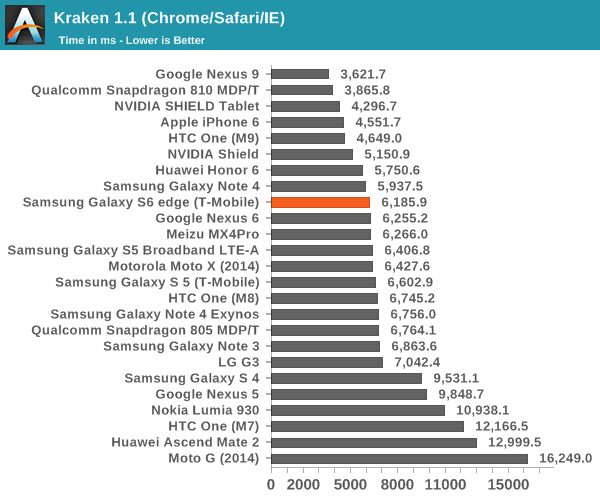
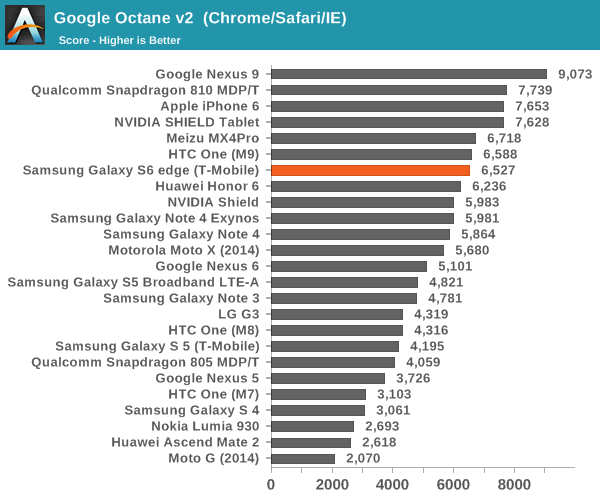
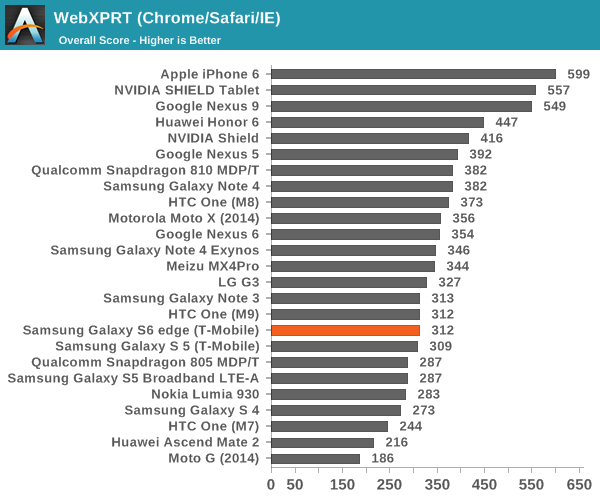
The Exynos 7420 is about on par with the Snapdragon 810 in these benchmarks. Strangely enough both tend to do worse than the Huawei Honor 6 in these tests, which clearly can't be correct. As we've previously discussed, the stock browser will often give far better results due to OEM and SoC vendor optimizations. As a part of our updates to the benchmark suite for 2015, we'll take a look at Basemark OS II 2.0, which should give a better picture of CPU performance in addition to overall device performance.
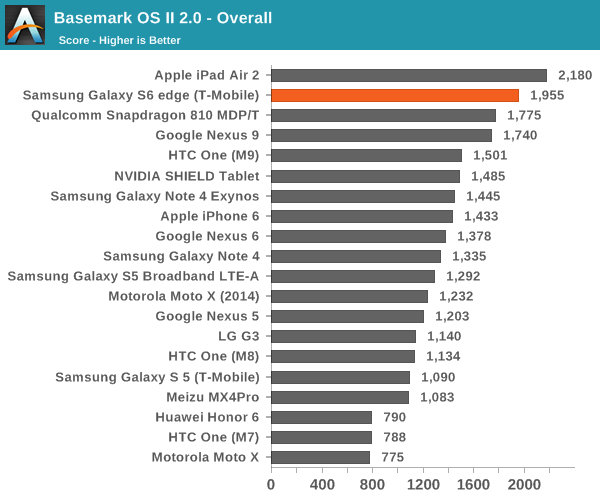
The browser benchmarks seem to hide some pretty enormous variability as the Galaxy S 6 edge (which is comparable to the Galaxy S 6) sets a new record among Android devices. The only challenger is the iPad Air 2, which uses the A8X SoC with three Enhanced Cyclone cores and the semi-custom GXA6850 GPU.
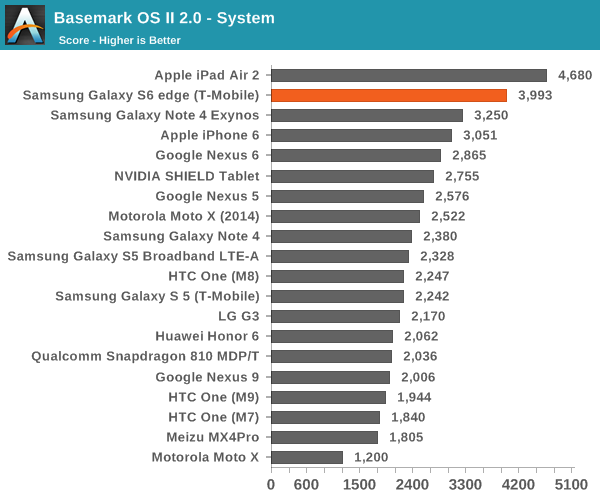
This system test contains a floating point and integer test, in addition XML parsing, which means that this test mostly stresses CPU and RAM. Interestingly enough, the Exynos 7420 pulls far ahead of both the Exynos 5433 and Snapdragon 810 in this test, and approaches the A8X. The difference between the 5433 and 7420 is likely a combination of the higher clocks on both the A57 and A53 clusters for the 7420 (1.9/1.3 on the 5433, 2.1/1.5 on the 7420), in addition to the ability to stay at a high 'overdrive' clock due to reduced leakage from the 14LPE process. The One M9 likely falls a bit short here due to HTC's governor settings restricting the use of all 8 cores simultaneously.
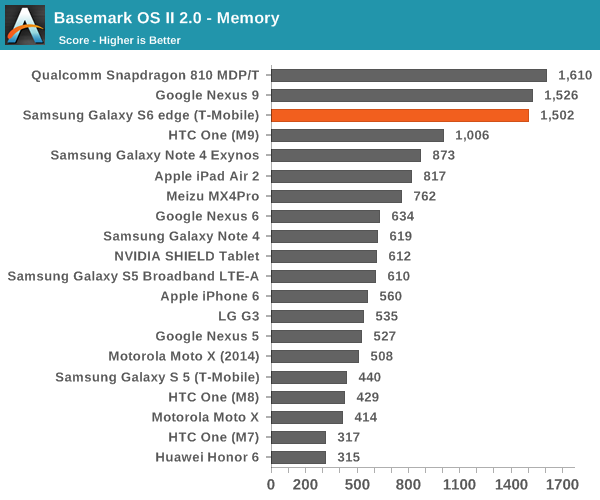
While one might guess that the memory test of 'Basemark OS II 2.0 - Memory' is of RAM, this is actually a test of the internal storage. Once again we see the S6 edge come close to leading the pack due to the use of the new UFS (Universal Flash Storage) standard. Casual examination reveals that the S6 edge has a queue depth of 16, and that it identifies itself with the rather cryptic model name of KLUBG4G1BD-E0B1.
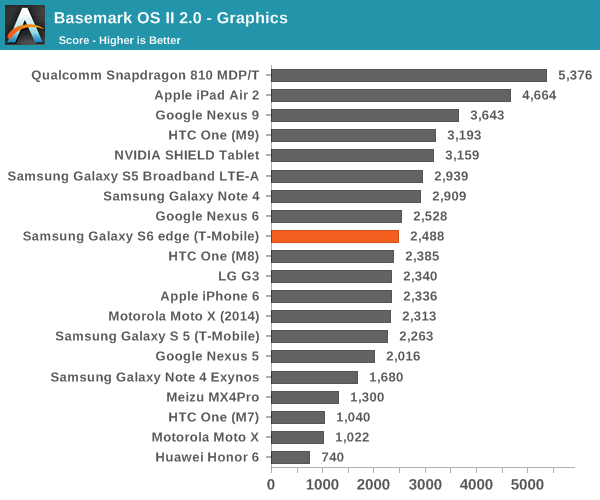
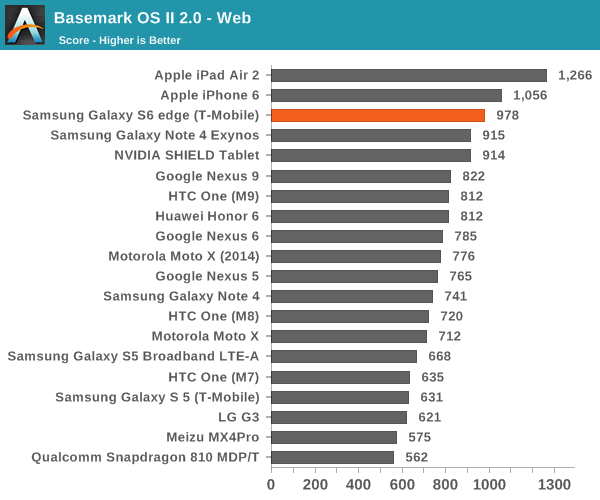
For the web test, it uses the built-in WebView rendering engine rather than Chrome and paints a distinctly different picture, especially because these tests are focused on HTML5 and CSS rather than JavaScript. Here we can see that the iPhone 6 and iPad Air 2 continue to hold their lead, but the Galaxy S6 is pretty much the king of the hill when it comes to Android devices.










200 Comments
View All Comments
Darkito - Thursday, March 26, 2015 - link
I should say I have an almost four year old SGSII and I still get a full day's charge now that I've gotten rid of wakelocks.steven75 - Friday, March 27, 2015 - link
So all he needs to do is basically root his phone and fix it himself. That sounds like a great experience worth paying a premium for! /skhha4113 - Thursday, March 26, 2015 - link
Your wife's S4 lasts for only 3hrs? Either the battery is bad or something wrong with the phone. My wife's can go almost a day (10hrs) for the same as yours (almost 2 tears).robertkoa - Thursday, March 26, 2015 - link
I think the biggest advantages are Touchwiz will have much less lag and the Camera is on par and in some ways superior to Note 4 ( low light only and manual control) with same sensor.I have heard ( unconfirmed) that Battery is Tech Replaceable and I agree that degradation after 200 to 500 charges is a concern.
I am surprised that Benchmarks are not higher though not a big concern to me.
Samsung COULD have made these 1 millimeter thicker and had about 25% more battery capacity!
Do you really need it this thin ?
I need the Camera but hope for a Note 5 Compact with about 4.7" or 4.8" screen and about 8mm thick strictly business same features Camera and price as Note 5 for pocket power.
Still the S6 is functional stylish , speedy and fluid despite Benchmarks here- amazed that Iphone6 smokes it mostly...don't care too much but those Apple Guys know their stuff.
The Hype was S6 was going to beat eveything by a mile...what happened ?
danbi - Saturday, March 28, 2015 - link
Of course, Samsung could have installed a bigger battery. But this could have resulted in:- more heavy device;
- thicker device;
- slower charge;
- need for more durable charge/discharge circuitry (cost);
- more expensive;
Samsung competes for each of those parameters with others. We don't know their design goals, but likely these are "make a device that has comparable feel in the hand to the iPhone" -- so it can't be much more thicker and heavier.. Things like that.
Do not worry. Samsung makes a plethoria of mobile devices. They will also make a thicker and with larger battery device. It will just not be the Galaxy S6.
Perhaps a solution is an "built to order" model.. who knows.
jospoortvliet - Sunday, March 29, 2015 - link
Add one item to that list:- thicker than the iPhone 6
it is the only reason that counts. The 10 grams and 1 mm extra a larger battery would take would not bother any user...
Walkop - Sunday, March 29, 2015 - link
Don't forget that higher resolution does NOT necessarily mean worse display power consumption with AMOLED. You don't need a more powerful backlight to punch through the pixels because the pixels ARE the backlight. Much more suited to high-density panels than LCD.DaBruinz - Wednesday, April 1, 2015 - link
Displaymate measured this display at 20% better than the S5 and 23% better than the iPhone. SAMOLD is very efficient and hey seem to be improving it constantly.1805 - Wednesday, April 1, 2015 - link
I wouldn't worry about battery lifehttp://www.phonearena.com/news/Our-Samsung-Galaxy-...
SmartPhones Watch - Thursday, April 9, 2015 - link
The battery seems not to be much good in S6 Edge and using of an secondary external battery has been avoided due to the non-removable battery in S6 Edge :( Samsung will have to really put more work on their battery efficiencyhttp://smartphoneswatch.com/samsung-galaxy-s6-edge...